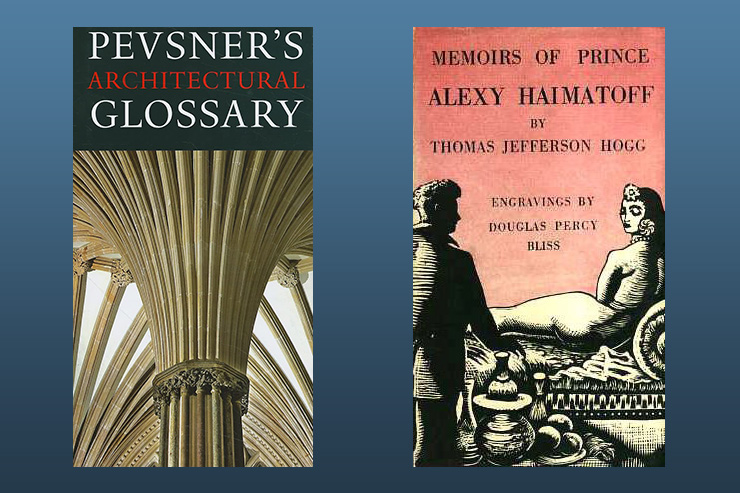
Chronicles readers familiar with today’s prestigious university presses know that, rather than disseminating, albeit to small audiences, the results of new, genuine research—their former charge—most have embraced progressive political causes. They censor or “cancel” worthy material because it does not conform, or is unrelated, to today’s pieties. They use supervising boards and outside readers, carefully selected, to legitimize their choices and rejections, making sure that their progressive bona fides are preserved. Meanwhile, the writing is often sloppy.
Pevsner’s Architectural Glossary (Yale, 2010), published with the support of The Pevsner Books Trust, is a welcome exception to these general trends. Nikolaus Pevsner (1902-83) remains known for his Outline of European Architecture and his series of guides to buildings in the British Isles, on which this handbook is focused. Directed toward a general literate audience, it is user-friendly, requiring little background beyond a knowledge of English and an interest in architecture. The organization is alphabetical. The entries include definitions of terms, styles, and features as well as descriptions of important ecclesiastical, public, and domestic buildings. There are 53 colored plates, with brief commentaries, along with a series of roundels (emblems) and 41 original line drawings, detailing structural and decorative elements.
Spanning a millennium of building, the book is grounded in history, but political, religious, social, and military aspects of historical periods are reflected only indirectly, in architectural features (drawbridges, great rooms, and so on). While not presenting new research, the work is authoritative, and the investigations on which it is based were largely those of Pevsner himself. Academic snobs may consider the project as recycled or popular art history, or even dilettantish. Hardly!
The handbook gives both pleasure and profit. You may use it for reference; you may browse; you may admire the photographs and study the line drawings. In short, the guide can be an auxiliary to reading or the reading itself. At best, it would accompany you on your next journey to the British Isles or even on a tour of cathedrals on the Continent or in the New World.
The book can be contrasted favorably with another from Yale, The Arts of Intimacy (2009), likewise concerned with architecture and decorative influences. That study is, unfortunately, tendentious; its Islamophile authors want to prove that Islam created harmony (“intimacy”) on the Iberian Peninsula.
—Catharine Savage Brosman

Thomas Jefferson Hogg’s early 1800s novel, Memoirs of Prince Alexy Haimatoff, purports to be the reminiscences of a Russian of mysterious, probably royal, parentage.
Hogg (1792-1862) wrote on antiquity for both the Edinburgh Review and the Encyclopaedia Britannica but is mostly remembered today as Shelley’s first biographer. They had been friends at Oxford, from which they were both expelled in 1811 for co-writing a pamphlet arguing for atheism. Shelley later suspected Hogg of designs on his wife, Harriet, but when Haimatoff came out, Shelley gave the book a mostly positive review.
Haimatoff is clearly the work of a young man, dashed off in overwrought style. It is full of Romantic cliches—mysterious origins, a dark and dashing hero, dangerously sensuous or implausibly angelic women, doomed love, German castles, corpses in crypts, duels, Greek ruins, Ottoman harems, secret societies, strange ceremonies, slave markets, sword fights, and bouts of insanity.
There are digressions about Aristotle, book learning versus native genius, happiness, mortality, and the alleged awfulness of the Catholic Church and the Ottomans. The hero expounds on “universal liberty” in classical landscapes. Like Byron, Hogg was a Hellenophile and Turcophobe, and there is an epic swim in Haimatoff reminiscent of Byron’s crossing of the Hellespont.
The plot is jerky and disconnected, and Haimatoff himself is unlikeable. Notwithstanding his fixation on universal liberty, he buys a sex slave in Constantinople, although he sets her free (but only because she is beautiful). And his Whig principles do not prevent his ingratiating himself with a Tory whose daughter he desires.
There are also moments, though, when Haimatoff can be ardent, imaginative, and vigorous: “The sable honours of his head have perished; they once waved in the wind like the jetty pinions of the raven; the skull is only covered by the shrivelled skin, which the rook views wistfully, and calls to her young ones.”
Reading this recalls a time when Romantic ideas were upturning everything Augustan and restrained, with still-reverberating consequences. Greater writers would develop Hogg’s themes, but Haimatoff was an early ingredient in that revolutionary ferment. Shelley was right to see the book as “an unweeded garden where nightshade is interwoven with sweet jessamine, and the most delicate spices of the east peep over struggling stalks of rank and poisonous hemlock.”
—Derek Turner

Leave a Reply